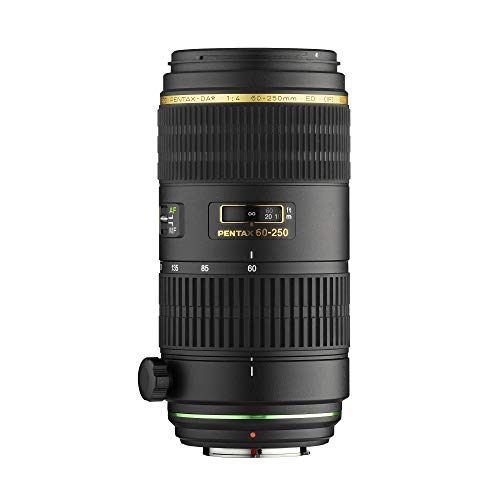Product Description
Pentax SMC DA 60-250mm F/4 ED (IF) SDM Lens – Versatile Super-Telephoto Zoom
High-Performance Telephoto Zoom for Sports, Wildlife, and Action Photography
The Pentax SMC DA 60-250mm F/4 ED (IF) SDM is a premium super-telephoto zoom lens, offering a constant F/4 aperture across the zoom range for reliable performance in a variety of lighting conditions. Designed for Pentax APS-C DSLR cameras, this lens provides an effective focal length equivalent to 90-375mm in full-frame terms, making it an excellent choice for sports, wildlife, and action photography.

Featuring two Extra-Low Dispersion (ED) glass elements, Pentax’s unique SP coating, and a weather-resistant construction, this lens ensures sharp, high-contrast images with excellent durability. The SDM autofocus system delivers fast, silent, and accurate focusing, with Quick-Shift manual focus override for greater precision.
Key Features & Benefits
Versatile Telephoto Zoom with Constant F/4 Aperture
- Covers 60-250mm on APS-C sensors, equivalent to 90-375mm on full-frame.
- Bright F/4 aperture throughout the zoom range, providing consistent exposure and depth control.
- Ideal for wildlife, sports, and action photography, offering excellent reach and sharpness.

High-Performance Optics for Superior Image Quality
- 15-element optical design with two ED glass elements reduces chromatic aberrations for clear, high-contrast images.
- Optimised optical coatings minimise ghosting and flare, ensuring sharp details even in backlit conditions.
Fast & Silent Autofocus with Manual Override
- SDM (Supersonic Drive Motor) autofocus system provides quick and near-silent focusing.
- Quick-Shift Focus System allows for instant manual focus override, providing greater control for precise adjustments.
- Compatible with Pentax’s KAF2 mount, allowing use with older Pentax bodies that rely on body-driven autofocus.

Weather-Resistant Construction for Outdoor Reliability
- Dust and moisture-resistant housing ensures reliable performance in harsh conditions.
- Pentax’s SP (Super Protect) Coating repels water, dirt, and grease, making the front element easy to clean.
Tripod Collar for Added Stability
- Rigid, detachable tripod collar provides enhanced support for long-duration shooting.
- Rotating design allows for quick switching between horizontal and vertical composition.
Dedicated Lens Hood with Polariser Adjustment Window
- Custom lens hood with a removable window allows for easy access to adjust a circular polarising filter.

Why Choose the Pentax SMC DA 60-250mm F/4 ED (IF) SDM?
- Long-range telephoto zoom with constant F/4 aperture for professional-quality shots.
- Premium ED glass elements for reduced aberrations and high-contrast images.
- Fast, silent autofocus with manual override for precision control.
- Weather-resistant build with SP coating for outdoor shooting.
- Versatile tripod collar for added stability and easy composition adjustments.
Capture Every Moment with the Pentax SMC DA 60-250mm F/4
For photographers who need reach, flexibility, and consistent performance, the Pentax SMC DA 60-250mm F/4 ED (IF) SDM delivers exceptional optical quality and fast autofocus in a durable, weather-sealed design. Whether shooting sports, wildlife, or landscapes, this lens offers unmatched versatility and reliability.
Payment & Security
Your payment information is processed securely. We do not store credit card details nor have access to your credit card information.
New content loaded

























